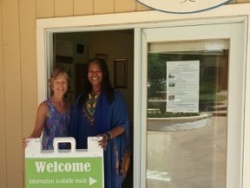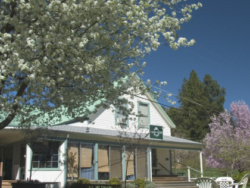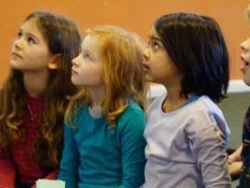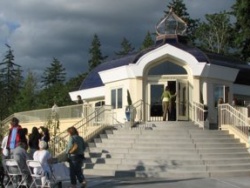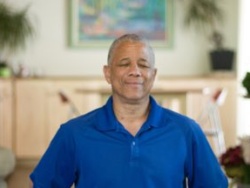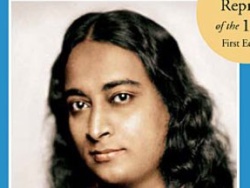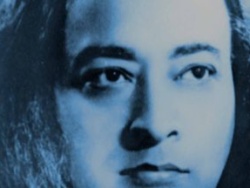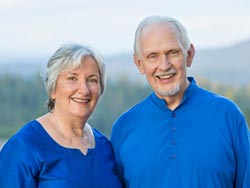I first learned about Ananda after I had been divorced for a couple years and was raising my two children. Having gone through the trauma of having the normal middle class lifestyle fall apart on me, I was seeking a more fulfilling way to live. It was the early seventies and I was living in Berkeley, experimenting with yoga and meditation. I had read Swami Satchidananda’s book on Integral Yoga Postures, which was a book that introduced many people to hatha yoga. I also got involved with Transcendental Meditation.
My love for the outdoors encouraged me to take a class in “Edible Plant Life and the Evolvement of Spring, from Death Valley into the Sierra Nevada Mountains.” During this class I met Durga and we developed a friendship. At that time she was involved with a yoga group and was attending their meetings and retreats. We eventually started living together and pursuing our mutual interest in yoga.
In the early seventies we both attended a conference in San Francisco called The Meeting of the Ways. Kriyananda was sharing a speaking platform with Swami Satchidananda, whom I always respected, and Yogi Bhajan, who taught kundalini yoga. I was very impressed with Kriyananda, and his interest in cooperative communities. He talked about Yogananda’s plain living and high thinking principles, which I felt very drawn to.
We eventually moved to Ananda in the summer of 1974 with our two children, Melissa and Dwayne. Our first home was a tent at Ananda’s Seclusion Retreat. We lived on Sunset Boulevard, which was a fancy name for an old dirt road we all took to view the sunsets on Bald Mountain.
Since I had been a successful construction worker, I was able to get work outside of Ananda. I also had savings that allowed us to live the simpler Ananda lifestyle. The first nine years at Ananda I worked four to six months of each year away from the Village. At one time I even worked on the Alaskan pipeline. As a householder, this worked very well for my family. Unlike the city, there wasn’t much economic structure here that could support families. My working outside the community allowed Durga to work or volunteer within the community and it offered my children a chance to grow up in a beautiful rural environment.
The development of children at Ananda differs from other places mainly because we use the Education for Life principles, based on Yogananda’s teachings. We honor the uniqueness of each child and work to draw out his or her highest potential not by pushing, but by leading. Common sense values like kindness, love and honesty are instilled at a very young age so the children can learn to incorporate these values into their own way of being.
I first began working for the community when Kriyananda asked me to help build the Crystal Hermitage. He had received an inheritance from his father and wanted to build something that the community could also enjoy. Before Ananda, I had worked in the highly competitive environment of general contracting, which meant getting the job done at the lowest cost was the bottom line. Here at Ananda I entered a whole new environment where concepts like “People are more important than things,” and “Instill everything you do with God remembrance” were being practiced. Ananda is a big experiment in how to achieve these principles and survive on a practical level. There has to be a balance between the spiritual and the practical, a balance that helps us draw the best from both.
Bringing these concepts into the workplace is achieved by first bringing them into your consciousness. We would begin each workday in a circle with prayers and dynamic affirmations. We would stop at noon and meditate for a half hour. We encouraged everyone to be high-minded on the work site. For instance, we would try to help someone who had the spirit but not the efficiency to do a job, and we would try to create a space for them to grow. We worked hard, but also had fun. This is a path of joy, so we were trying to stay loose while doing the best we could. These principles can change your whole outlook on life when put into practice.
Seeing one’s work as service ultimately means not being attached to the fruits of your labors. The attitude with which a person performs his work allows him or her to serve God through that work. It’s reflected in how he treats people he comes into contact with through his work, and even what he does with the fruits of his labors—like tithing. Bringing the proper attitudes of being positive, energetic and enthusiastic to whatever one does is one of the ways we work here. The old adage “Act enthusiastic and you’ll be enthusiastic, feel enthusiastic and you’ll be enthusiastic” contains many of the principles of yoga. Keeping the energy high, in the upper chakras, and being expansive and serviceful are other important attitudes we try to incorporate while working.
My favorite jobs at Ananda are projects that can be manifested on the physical plane. I suppose my background in construction finds fulfillment in concrete things! My strength lies in the ability to find people who can do what I cannot do, and then to support them, give them energy and empower them. I have been fortunate to work with a lot of people here I felt attunement with and trusted. Projects happen here through the magnetism, love, support and energy of a group of us working to serve a greater work, serving God.
In order to create magnetism you need to rely on a few basic principles: magnetism is produced by having energy, and you must have enthusiasm yourself to inspire it in others. As a good leader you must be willing to roll up your sleeves and dive right in with the rest of the workers. If they believe you’re committed at this level, there are very few people who will not be magnetized as well. However, you cannot project on others your own style of magnetism. You can only help them perform to their highest level. First, you must magnetize yourself to your highest level. If you look at the great saints like Yogananda, they always used their spiritual practices to generate the magnetism they needed.
Ananda’s success goes right to the heart of cooperative communities. Here, there are people who share common spiritual goals that enable us all to be in tune at the deepest spiritual level. This allows us to communicate on a soul level and accounts for harmony amongst people. Our spiritual connections give us a unique willingness to work together despite more superficial personality differences. Common spiritual goals have given us the strength to grow through many kinds of trials. We go to the temple and worship in the same way and we develop an attunement that allows us to work through difficulties without becoming unraveled at the surface.
I am always surprised at the fact that Ananda still exists. I have often wondered if we could make it this far. From a purely business perspective these principles probably seem surreal, but there has been a level of Divine Grace that has also helped us. I think the universe has responded to the sincerity and dharma of our position. We still have to work hard, which we do, but there is a divine spiritual connection that allows us to move forward as a family. I’ve also never felt that Ananda has reached its final form. We’re adaptable. Our willingness to take a fresh look every day at the situation that confronts us allows us to be adaptable—even if this means changing preconceived ideas.
From a political standpoint, the core values of Ananda very much represent the early values that America was founded on—in God we trust. Kriyananda laid down the principle that the primary job of the spiritual director of Ananda is to guard the rights of the individual. He once said, “You do not exist for Ananda, Ananda exists for you.” When you have many people enacting this principle, people look out for one another. For instance, the primary role of a minister here is to put the needs of others before his own.
One of the major turning points for me occurred when Kriyananda suggested things for me to do that he knew would help me grow and I balked at them. I remember I was driving the Joy Singers around the country and had said “No, thank you” to another tour. He asked me privately about going on another tour, and told me the work needed me to do it. This was a great turning point for me because, all of a sudden, it shifted me from thinking about doing something for myself to realizing that I had a way to serve a person from whom I had drawn so much inspiration. It was a major test for me. I had to sacrifice making a big income and do something I didn’t really want to do. But everything worked out well. I retired from a lot of opportunity and income I could have taken advantage of, yet I have still had a life that’s wonderful. I’ve traveled all over the world, and I was able to raise my children in a great environment. I don’t have any money in the bank, but Divine Mother and God’s grace has kept me in a fine style. No other way of living would allow me to have the time, freedom and the satisfaction of having done something meaningful with my life beyond just working and acquiring material possessions.
I do miss the days when Ananda was a much smaller, more intimate group of people. It seems that now we have the dharma to demonstrate the viability of this lifestyle to others. In order to do this, we’ve had to raise our living standards to a level that would be more middle class. This has put a lot of stress on us financially, and it has taken a lot of work. The earlier, simpler lifestyles here just wouldn’t be suited to our current dharma.
I would hope that there is something that mainstream America could learn from communities such as Ananda. What really makes a community like this work is not a particular list of things. There are attitudes that exist here, ways of dealing with people and principles that make it work. The main attitudes are the basic tenets of our core belief system: service, attunement, guarding the rights of the individual, and people are more important than things. I don’t believe that people can live this closely together for so long without a core belief system. Even the way we govern the community has been divided up with a spiritual director, a general manager, and an elected Village Council. All have influence, but ultimate decisions go to the spiritual director so that everything is viewed from a higher, spiritual level.
One of the most important lessons I’ve learned here is how to serve. The way to break the cycle of personal troubles or worries is to get out of yourself and to serve others. Then watch the transformation. The people here are the fruits of an effort to live the spiritual life to the best of their ability. There are not a lot of saints here, but there are many trying to live in God-remembrance. It is a great privilege to live amongst people with this level of fellowship, brotherhood and connectivity. I have more than 200 friends whom I could trust with my life. I know they would do anything within their ability for me. That is God’s response to us, as God works through people around us. In the whole cosmology of yoga, people are the greatest instruments through which the Divine can flow.

